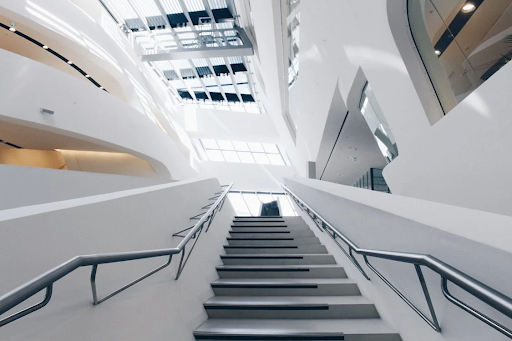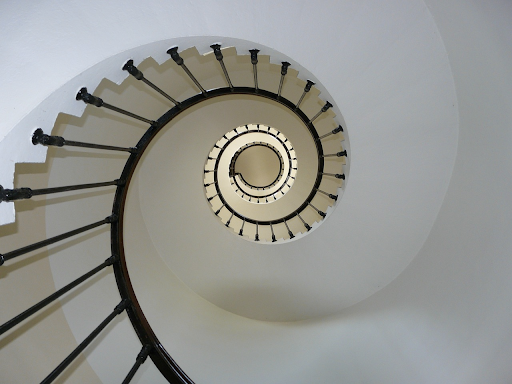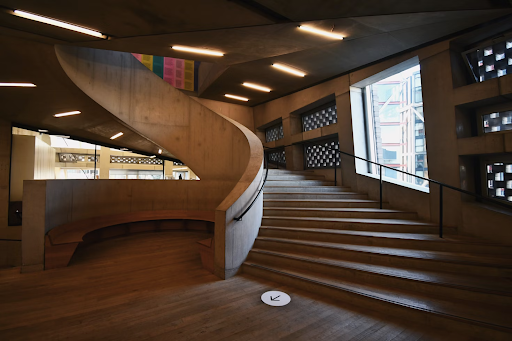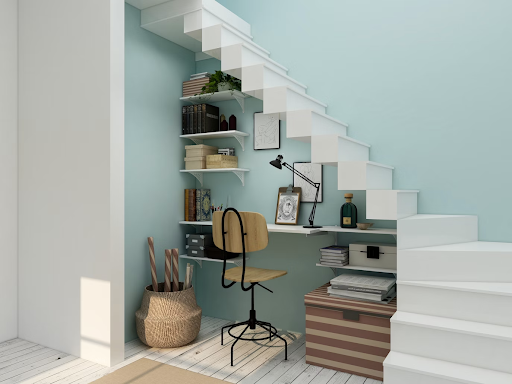
As an engineer, for almost any project, you will need to spend time thinking about the type of stairs that would suit your building best. So, let’s look at seven options for staircases – followed by some of the most popular choices of stair treads.
1. Straight Stairs
The straight staircase – ah, the good old reliable option! Straight staircases are your bread-and-butter stairs, running directly from one floor to the next without any turns or curves.

Their simplicity makes them a cinch to design and build, which can be kinder on your budget, too. If you've got a more straightforward architectural style or want to maximize ease of navigation in your space, straight stairs have got you covered.
Plus, they are versatile; toss in an intermediate landing if you need a breather halfway up, or opt for a top landing for some extra space before you hit the next floor's hustle and bustle.

Image source: https://pixabay.com/photos/staircase-upwards-rails-railings-274614/
2. Spiral Stairs
Spiral staircases are like the cinnamon swirls of the architectural world – they save on space and look sweet doing it. They snake upwards in a helical arc, making them perfect for tight spots where traditional stairs just wouldn’t fit.
Going for that 'wow' factor? Spirals are your go-to, delivering a dash of elegance and a twist of modernity. They are ideal for both urban dwellings and as secondary staircases in larger buildings.
3. Quarter-turn Stairs
Ever seen stairs that take a sharp turn like they have just decided to change direction midway? Those are your quarter-turn, or L-shaped, stairs.
They throw a 90-degree bend into the mix. So, if you are all about utilizing corners and want some privacy between floors, these twists in the tale are spot-on. They're safer too – less of a tumble if someone’s slip-sliding away due to the landing breaking up the descent.
They are perfect for residential nooks or office crannies where space and safety dance together.
4. Switchback Stairs
Switchback stairs, or U-shaped stairs, are not ones to go with the flow; they do a full 180 on you. Picture two parallel flights connected by a landing that levels up your design game.
They're stellar for splitting up the climb and can fit nicely into a building plan without hogging all the real estate. If you've got some square footage to play with and crave an orderly, compact design vibe, these switchbacks have your name on them.
Plus, they make it super easy to include a dramatic focal point like an overhead light fixture or an art piece.
5. Scissor Stairs
Scissor stairs are like the Swiss Army knives of stair design—sleek, compact, and super-efficient. They feature two interlocking staircases offering separate upward and downward routes in one single slice of architectural genius.
Ideal for busy buildings where traffic flow is high, these stairs keep folks from playing chicken on the same flight. For structures craving streamlined foot traffic management without gobbling up space—or if you have got to meet stringent fire escape codes—scissor stairs cut to the chase brilliantly.

Image source: https://unsplash.com/photos/a-spiral-staircase-in-a-large-building-with-wooden-floors-rfTiBLJJgO0
6. Curved Stairs
Curved stairs are the red carpet of the staircase world, bending gracefully to elevate not just your feet but the room's entire aura. They arch elegantly from one level to the next without the sharp corners of switchbacks or spirals, offering an effortlessly flowing transition.
Dreaming of a grand entrance? A curved staircase can deliver that grandeur, making it ideal for luxe homes, galleries, or corporate lobbies. They are also a hit for their natural walking path—easier on the joints than taking acute angles.

Image source: https://unsplash.com/photos/black-metal-framed-brown-padded-chair-beside-white-wooden-shelf-qT6SW5vmaiM
7. Floating Stairs
Floating stairs, which are also known as cantilever stairs, are the modern art piece you can walk on. These stunners have steps that jut out from the wall with no visible support underneath, giving them a magical hovercraft vibe.
These stairs are perfect for minimalistic or contemporary spaces where every detail is an expression of chic design. They don't just save space—they turn it into a visual feast of clean lines and open airiness.
If your building aims to make jaws drop with its avant-garde aesthetic , floating stairs will fit right in and stand right out.
Types of Stair Treads
You also need to consider stair treads. So, here are some of the best and most popular choices.
Concrete-Filled Metal Pan Stair Treads
First up: concrete-filled metal pan stairs . They are as tough as nails and ready for anything.
Picture a metal skeleton that's been packed with concrete—this combo brings you stairs that can take a beating while keeping their cool, noise-wise.
They are superb for high-traffic zones like commercial hubs or industrial settings where durability takes the front seat. And they will not flinch at heavy loads or constant footfalls. They laugh in the face of wear and tear, too.
Metal Diamond Plate Stair Treads
Metal diamond plate stair treads are all about grip and grit. Decked out with a raised pattern that looks like a field of mini pyramids, these bad boys offer top-tier traction.
These treads are ace for industrial scenes where slips and slides cannot afford to be on the menu or in any spot that gets hit with spills or slick conditions.
If your build is one that deals with rough-and-tumble use and needs sure-footing, diamond plate treads stand up to the task without breaking a sweat.
Precast Concrete Stair Treads
Precast concrete stair treads are like the parking garage of stair options—pre-made, rugged, and ready to roll. These bad boys are churned out in factory settings, ensuring consistent quality and a bespoke fit for your specific staircase needs.
They are ideal for those who are all about no-nonsense durability and low-key maintenance. Plus, they are champs at handling the outdoor elements with a sturdy defiance against Mother Nature's mood swings.
If your project is itching for steps that promise longevity with a clean, industrial flair—these precast workhorses will not disappoint.
Metal Treads with Abrasive Epoxy Coating
Lastly, abrasive epoxy coating on metal stair treads is like giving your stairs superpowers: traction and toughness. This dynamic duo of gritty material layered over sturdy metal means slips and slides stay in the playground, not on your staircase.
They are ideal for spots where spills or slick shoes could cause a cartoon-like wipeout, such as an industrial setting with safety at the forefront ; or public spaces where accidents are waiting to be lawyered. These treads have got grip that will not quit and durability that lasts ridiculously long.
Final Thoughts
As we have seen, there are a number of different staircase and stair tread options available. It is up to you to determine which ones are best suited to the specific engineering project you are working on.



